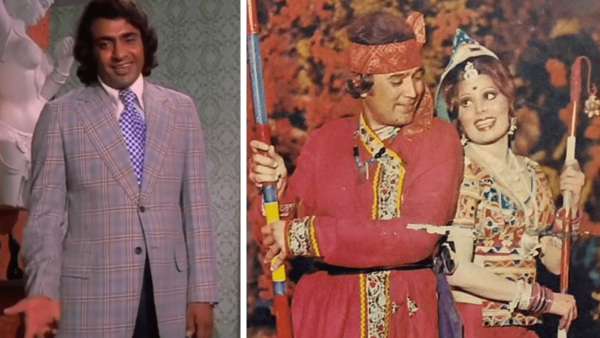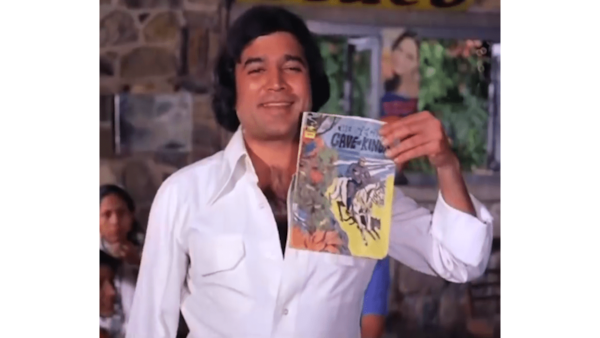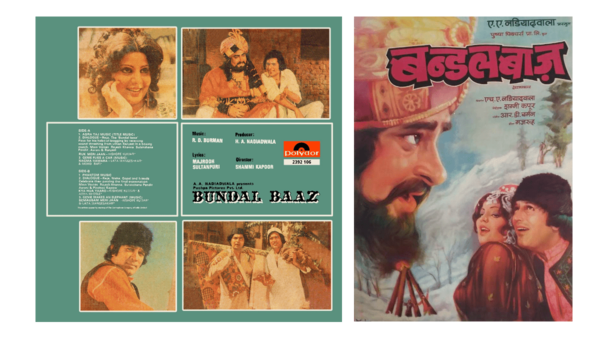Bundal Baaz: Did This 1976 Bollywood Classic Inspire Face/Off?
In #BizarreSpotlight, author Amborish Roychoudhury shines a light on overlooked Bollywood gems from his 'cabinet of curiosities'. Today: Rajesh Khanna-Shammi Kapoor's Bundal Baaz.

The demon, the genie, and the hero. Bundal Baaz
Last Updated: 07.08 PM, Jun 25, 2023
This column was originally published as part of our newsletter Stream Of Consciousness on June 25, 2023. Subscribe here. (We're awesome about not spamming your inbox!)
***
BACK in 1997, Hong Kong action veteran John Woo directed a film called Face/Off, where John Travolta and Nicolas Cage swap faces and destinies. It generated sufficient hype and was a multimillion-dollar global box office sensation. Among other things, what captured the audience’s imagination was the basic concept of the hero and the villain trading their appearances. Both Travolta and Nick Cage get to play the good guy as well as the psycho. Nifty, right? But what if I were to tell you that Bollywood nailed this idea long before Nick Cage was even a blip on anyone’s radar, and John Travolta was just a young singer?
Twenty one years before Face/Off, Shammi Kapoor conceived of a film primarily targeted towards children, called Bundal Baaz (1976). Shammi’s directorial debut Manoranjan (1974), his take on Billy Wilder’s Irma La Douce (1963), wasn’t well received. Since this was an adult-themed film, for his next, he decided to walk in the other direction --- a Disney-esque tale about Aladdin and his magic lamp (Disney’s own Aladdin film was still almost two decades away). Shammi had originally planned to cast Amitabh Bachchan in the lead, but by this time, Zanjeer, Deewaar and Sholay followed closely on the heels of each other, and Bachchan was at the top of his game. To get his dates was next to impossible. The next choice was Rajesh Khanna --- a costly mistake, as it turned out. But more on that later.
Much like that celebrated Christopher Nolan Batman movie we all love to gush about, Bundal Baaz starts with a bank robbery. Five unmasked men wearing hats and suits rob the Bank of Bombay and take off. They don’t notice the canine witness they left behind. The mongrel wastes no time and runs back to its abode, a cave that looks like a yawning skull (you can’t help but notice that the dog switches breed midway). In the cave, on his skull throne, sits The Phantom.
Now, a Marvel-raised generation might not even know who The Phantom is. Or was. Variously known as The Ghost Who Walks and the Guardian of the Eastern Dark, The Phantom is a masked hero believed to have survived for centuries (secretly, it is a mantle that is passed on from one generation to the next), and fights crime in the deep jungles of Africa. His iconic skull cave is known to be in the depths of Bangalla, a fictional African nation, where the Phantom combats evil astride his noble steed Hero, accompanied by his faithful wolf Devil.

In the much-improved Bollywood version, however, Rajesh Khanna seems to be the Phantom and Devil is, well, a dog. And the skull cave, as we soon learn, is in the deep jungles of Juhu. Kaka as the Phantom rides his horse down Juhu beach, and finally tracks down the bank robbers, led by Ranjeet. Ranjeet and his minions are in a white hoodless car, tearing through the roads of 1970s Bombay, while Khanna aka the Phantom chases them on his white horse. “Phantom aa raha hai peechhe,” quips one of the goons, helpfully. But the desi Phantom soon catches up, unleashes a bagful of “dhishooms” on the robbers and hands them over to cops. The officer says “Shabash Mr Phantom! Desh ko tum jaise naujawanon ki zaroorat hai.”
At this point, Raja (Khanna) awakens from his reverie, holding a copy of Indrajal Comics #159: The Secret Cave of Kings. For the uninitiated, Indrajal Comics was a wildly popular brand of comic books which had titles like Mandrake the Magician, Flash Gordon, Buzz Sawyer, Garth and Bahadur. Lee Falk’s Phantom was their flagship title, also the most popular. Between 1964 and 1990 when it folded up, it was what every child obsessed over.

Back to the film: We learn that Raja is a daydreamer and a slacker, and is in love with his classmate Nisha (Sulakshana Pandit). Ranjeet (well, Ranjeet) is the college bully and never passes up the temptation to insult Raja. Of course, Raja is a poor bum and Nisha is a rich girl. Of course, Nisha’s father and the evil Ranjeet’s father are childhood friends and plan to get them married. Times are tough and Raja is now a ragpicker. He stumbles upon a bottle which he rubs, and voila! out pops a genie (Shammi Kapoor).
The genie fills Raja’s life with untold wealth, turning his house into a glittering palace. But Nisha’s father won’t budge, and Ranjeet is even more determined to destroy his rival. To protect him better, the genie gifts Raja a ring that, when twisted, manifests a demon from the netherworld (Dev Kumar) who yells “Aka-baka-daka-baka-zum-zum-bha”. Unimpressed, Raja tosses it away. The ring is picked up by Ranjeet and with the help of the “Aka-baka” demon, he shapeshifts into Raja. To his shock, Raja finds himself turning into Ranjeet. The next four minutes are unprecedented in the history of cinema.

Raja and Ranjeet have swapped bodies but their voices and their mannerisms are intact, unlike Face/Off, the poor imitation where they use scientific tomfoolery to change the voices of the actors. Not here. In the subsequent scenes, Ranjeet pulls off a near-perfect imitation of Rajesh Khanna and Kaka walks around trying his best to look vicious. For the first time in history, a much-maligned Bollywood villain, for a few minutes, gets to play the hero. Ranjeet smiles innocently and delivers signature Rajesh Khanna dialogues in signature Rajesh Khanna. It is a sight for sore eyes. It’s a bummer that the genie has to then turn things around.
When Bundal Baaz was released, it didn’t find an audience. With the entry of Amitabh Bachchan, superstar Rajesh Khanna was on a downward spiral as most of his films crashed and burned at the box office. Shammi had a hard time on the sets, dealing with Kaka, who was irritable, depressed and in a vicious mood. For days on end, he gave the dates but didn’t turn up. Apparently, despite committing to a 40-day stretch, he turned up on the set just for three days. The result was a film which didn’t quite turn out as expected. But over the years, Bundal Baaz found its audience through reruns on Doordarshan and other TV channels during the ‘90s.
Now, we know that Bollywood films are shown in Hong Kong. So, did a young John Woo catch a screening of Bundal Baaz on afternoon TV and marvel at its genius? We’ll never know.
Amborish Roychoudhury is the National Award-winning author of 'In a Cult of Their Own: Bollywood Beyond Box Office'.
